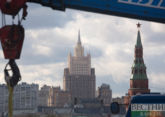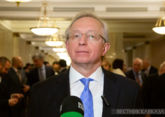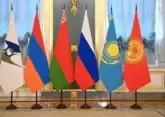Armenian President Serzh Sargsyan's visit to Moscow did not answer the main question: will the Kremlin let Armenia go to the European Union under the Eastern Partnership program? Sargsyan would like to keep a foot in both camps - in the Eurasian Union and in the European one, receive economic, financial and even military assistance in both Moscow and Brussels. No post-Soviet country has been able to do it yet.
As Gazeta.ru writes in the article 'Moscow lets Armenia go to the European Union', on Wednesday, Vladimir Putin held a meeting with Armenian President Serzh Sargsyan in the Kremlin. The official occasion for the visit was the opening of the Days of Armenian Culture in Russia. Even if the leaders discussed any problems existing between the two countries, they did not make it public. On the contrary, Putin decided not to discuss any problems, only praised his colleague for the "positive results" of bilateral cooperation in the sphere of political contacts and security. "The economic growth was fixed already last year, while this year this figure has already surged by one-third. This is gladdening, of course. I would like to see this tendency persist," Putin said. On the eve of a working visit to Moscow, Sargsyan also bombard with compliments. Yerevan needs to continue strengthening contacts with Moscow in all spheres, "any friendship requires wok," Sargsyan noted.
Sargsyan prepares two chairs
And he did a really good job for friendship. But not just with Moscow, but also with Brussels. The thing is that the EU-sponsored Eastern Partnership summit will be held in Brussels, where Armenia is expected to sign a new legal document - the Comprehensive and Enhanced Partnership Agreement. The Eastern Partnership project initiated by the European Union unites Azerbaijan, Armenia, Belarus, Georgia, Moldova and Ukraine. The project is aimed at adapting the former Soviet republics, their political structures and economies for the subsequent accession to the EU. Armenia intended to sign the association agreement with the European Union and create a free trade zone with it already in 2013. The signing of such a document is the first step towards joining the EU. A country which accepted a free trade zone starts using customs preferences and receiving grants.
Yerevan, by the way, has already received tens of millions of dollars under the Eastern Partnership program. Small Armenia has even become one of the largest recipients of funds per capita within the framework of this program. But at the last moment, President Sargsyan suddenly turned towards the Eurasian Economic Union and on January 2, 2015 Armenia joined the EEU. In political terms the process was not smooth. Approximately one third of Armenians was categorically against joining the EEU, the opposition repeatedly held rallies under the slogans "No forced USSR", "NoRussianEmpire".
Yerevan had applied the tactics of increasing the cost of the EEU entrance ticket - by delaying the negotiations. And it paid off: Moscow promised that if Armenia becomes its member, it will get 1.13% of the whole sum of customs duties from the import of goods into the EEU. In addition, it will be able to apply customs duties, different from those of the EEU, for a number of goods (including meat and meat products) until 2022.

Don't forget that Armenia has no common borders with the Customs Union. For example, it is cut off from Russia by the territories of Georgia and Azerbaijan. This was also taken into account in the agreement on Armenia's accession. A special procedure for the passage of goods between foreign states and the EEU member states was stipulated. The transition period for the adaptation of legislation, the unification of customs regulations and technical regulations was designed for an unprecedented period of eight years.
In addition, Armenia successfully claims the reduced cost of Russian gas - about one-third of those before 2015. It is clear that it fell to Russia as the largest player in the Eurasian Union to provide most of the preferences and benefits promised to Armenia. For example, last year Moscow granted Yerevan a $200 million loan for the purchase of military products. Another $40 million was a preferential loan from the Eurasian Development Bank.
Eurasia is not forever
The EU financial assistance looks more modest against this background. But Armenia did not refuse from it as well (the main creditors of Armenia are Japan, Germany and international development institutions). It was convenient to keep a foot in both camps. As soon as it joined the Eurasian Union, Armenia received another package of financial assistance from the European Union. In early 2015, the EU allocated Yerevan nearly €78 million. "The European Union believes that the Eurasian Union is not forever, it will collapse anyway, and therefore it is still relevant to adapt the legislation of its eastern neighbors, bringing it closer to the norms of the EU," the political scientist Andrey Suzdaltsev commented on the issue.
Of the total, the EU allocated €25 million for agriculture and poverty reduction, €10 million for employment and vocational training, €21 million for civil service reform and anti-corruption efforts, €4 million for border management and migration under the agreement on visa facilitation with the EU, €6 million for the strengthening of civil society, €5 million for the repair of the Yerevan Metro and €5.5 million for the improvement of water supply in Yerevan.
They even allocated money for the disposal of radioactive waste - € 1 million. The fact is that Armenia has a nuclear power plant with two power units. It covers up to 45% of the republic's electricity needs. After the 1988 Spitak earthquake, the nuclear power plant was stopped, but then one of the power units was again started. Brussels insists that it shut down the nuclear power plant, fearing that the reactor is obsolete and an emergency is possible.
In return, the European Union proposes to develop sustainable energy. But the Armenian government decided to extend the life of the second power unit until 2026. For these purposes, Russia granted a $270 million dollar export loan and a $30 million dollar grant.
The peaceful atom almost became a bone of contention between Armenia and the EU leadership. The Comprehensive Partnership Agreement, which Armenia is going to sign, even includes a separate chapter on this issue - 'Energy Cooperation, including Nuclear Security'. It says that energy cooperation should include, in particular: "the closure and safe decommissioning of the Metsamor NPP".
Moscow or Brussels

But how can Armenia shut down the nuclear power plant if it takes Russia's loan for its modernization? Or where to get money to build a new station, for which the EU pressed? According to preliminary estimates, the construction of a new nuclear power plant block would cost $5.5 billion. So, Sargsyan had to make excuses on the eve of his visit to Moscow: the EU no longer insists on the immediate closure of the nuclear power plant.
But the main problem on the way to signing an association agreement with the EU is, of course, the Karabakh conflict. The agreement says the right words about the importance of resolving the Karabakh conflict exclusively through negotiatios, within the framework of the efforts of the OSCE Minsk Group based on the principles of the UN Charter, the Helsinki Final Act and the non-use of force. But the real guarantor of the fact that the Karabakh conflict did not turn into a full-scale war between Armenia and Azerbaijan is Russia.
But if Russia wants Armenia to remain within the framework of the Eurasian Union, without shifting towards Brussels, then Moscow will have to assume all risks and responsibilities. "Including for the growth of trade turnover, for energy security, for the settlement of the Karabakh conflict and the cessation of military-technical cooperation with Azerbaijan," an Armenian expert Hayk Khalatyan told Gazeta.ru.
According to him, the European Union learned a lesson from the Ukrainian situation. Now the EU does not offer to make a choice - Moscow or Brussels, the European Union or the Eurasian Union, us or them.
Sargsyan can find the way to NATO

Sargsyan has repeatedly said that he prefers the eat cake and have it approach - to be friends and receive help from both the EU and Russia. "We do not want to make a choice between friends, we want to have as many friends as possible," Sargsyan said. Now he has more chances to stick to this policy. On Wednesday, members of the European Parliament adopted a resolution stating that the countries participating in the Eastern Partnership program, which have made substantial progress on EU-related reforms, should have the possibility of joining the EU. That is, it is recommended to abandon the eat cake and have it approach, the confrontation between the EU and the EEU is unlikely. It is noted that Georgia, Ukraine and Moldova have made significant progress on the reforms, and they will be able to benefit from the "free trade agreements and visa-free regime with the EU."
The adaption of this resolution by the European Parliament was timed to the summit of the Eastern Partnership, which will be held on November 24. I's not known yet whether Armenia will sign an agreement with the EU on its second try. Sargsyan has not yet made any statements on the results of his visit to Moscow. But if Armenia signs the document and becomes an EU partner, it can aggravate the opposition of the Collective Security Treaty Organization (CSTO) and NATO. In case of an armed phase of the Karabakh conflict between Armenia and Azerbaijan, Russia will be obliged to participate in the resolution of the conflict within the framework of the CSTO. Armenia is a member of the CSTO, which is the de facto military bloc of the Eurasian Union (and Tajikistan). While Azerbaijan and its "big brother" Turkey prefer to be friends with the North Atlantic Alliance Organization.










